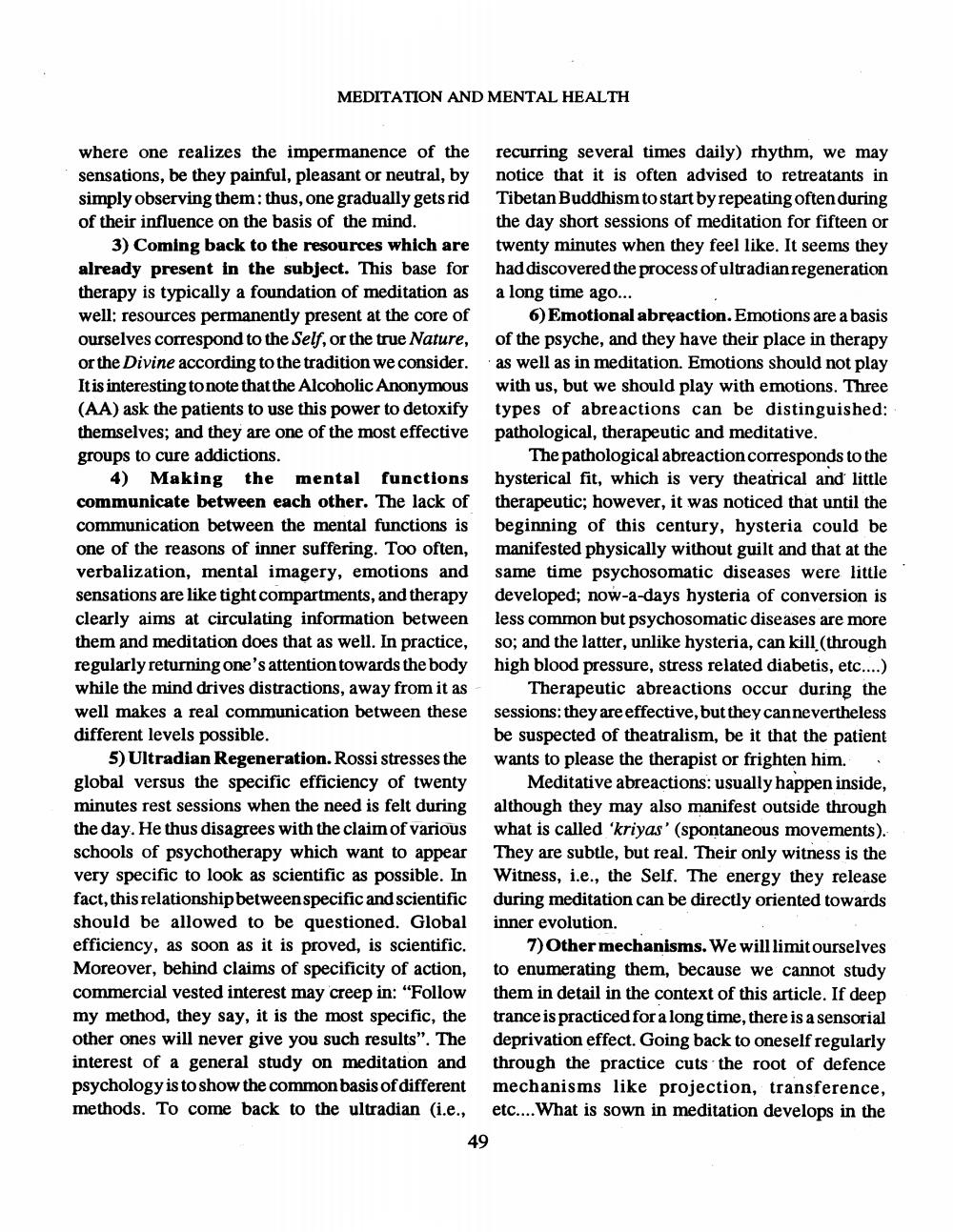________________
MEDITATION AND MENTAL HEALTH
OI
where one realizes the impermanence of the sensations, be they painful, pleasant or neutral, by simply observing them: thus, one gradually gets rid of their influence on the basis of the mind.
3) Coming back to the resources which are already present in the subject. This base for therapy is typically a foundation of meditation as well: resources permanently present at the core of ourselves correspond to the Self, or the true Nature, or the Divine according to the tradition we consider. It is interesting to note that the Alcoholic Anonymous (AA) ask the patients to use this power to detoxify
; and they are one of the most effective groups to cure addictions.
4) Making the mental functions communicate between each other. The lack of communication between the mental functions is one of the reasons of inner suffering. Too often, verbalization, mental imagery, emotions and sensations are like tight compartments, and therapy clearly aims at circulating information between them and meditation does that as well. In practice, regularly returning one's attention towards the body while the mind drives distractions, away from it as well makes a real communication between these different levels possible.
5) Ultradian Regeneration. Rossi stresses the global versus the specific efficiency of twenty minutes rest sessions when the need is felt during the day. He thus disagrees with the claim of various schools of psychotherapy which want to appear very specific to look as scientific as possible. In fact, this relationship between specific and scientific should be allowed to be questioned. Global efficiency, as soon as it is proved, is scientific. Moreover, behind claims of specificity of action, commercial vested interest may creep in: "Follow my method, they say, it is the most specific, the other ones will never give you such results". The interest of a general study on meditation and psychology is to show the common basis of different methods. To come back to the ultradian (i.e.,
recurring several times daily) rhythm, we may notice that it is often advised to retreatants in Tibetan Buddhism to start by repeating often during the day short sessions of meditation for fifteen or twenty minutes when they feel like. It seems they had discovered the process of ultradian regeneration a long time ago...
6) Emotional abreaction. Emotions are a basis of the psyche, and they have their place in therapy as well as in meditation. Emotions should not play with us, but we should play with emotions. Three types of abreactions can be distinguished: pathological, therapeutic and meditative.
The pathological abreaction corresponds to the hysterical fit, which is very theatrical and little therapeutic; however, it was noticed that until the beginning of this century, hysteria could be manifested physically without guilt and that at the same time psychosomatic diseases were little developed; now-a-days hysteria of conversion is less common but psychosomatic diseases are more so; and the latter, unlike hysteria, can kill (through high blood pressure, stress related diabetis, etc....)
Therapeutic abreactions occur during the sessions: they are effective, but they can nevertheless be suspected of theatralism, be it that the patient wants to please the therapist or frighten him. .
Meditative abreactions: usually happen inside, although they may also manifest outside through what is called 'kriyas' (spontaneous movements). They are subtle, but real. Their only witness is the Witness, i.e., the Self. The energy they release during meditation can be directly oriented towards inner evolution.
7) Other mechanisms. We will limit ourselves to enumerating them, because we cannot study them in detail in the context of this article. If deep trance is practiced for a long time, there is a sensorial deprivation effect. Going back to oneself regularly through the practice cuts the root of defence mechanisms like projection, transference, etc.... What is sown in meditation develops in the
49




